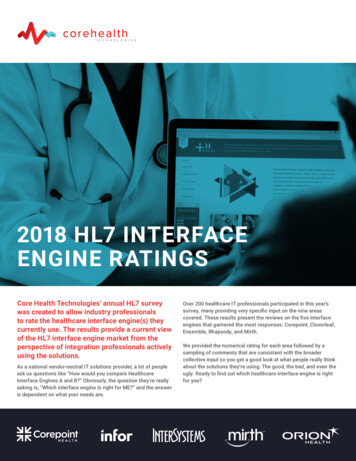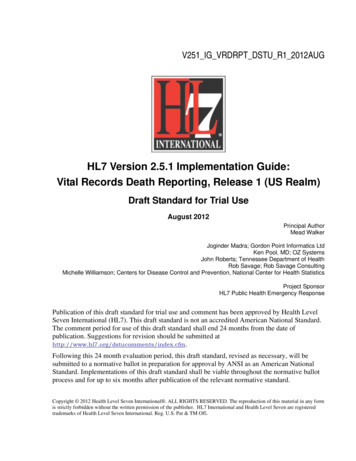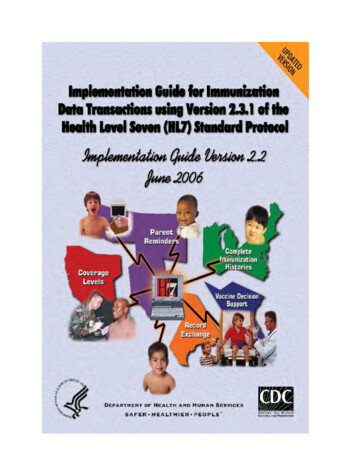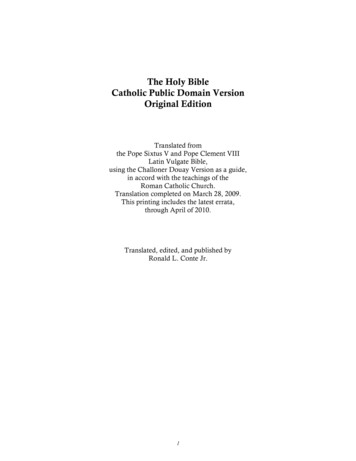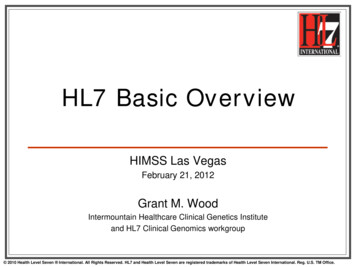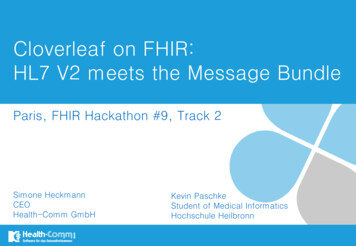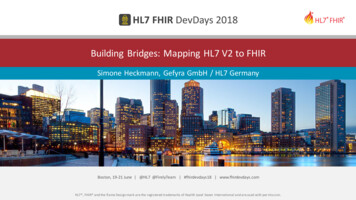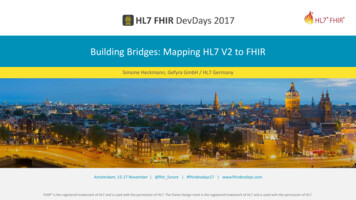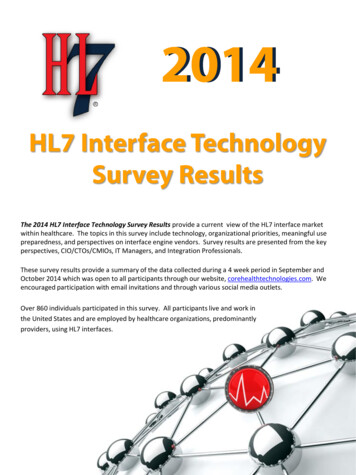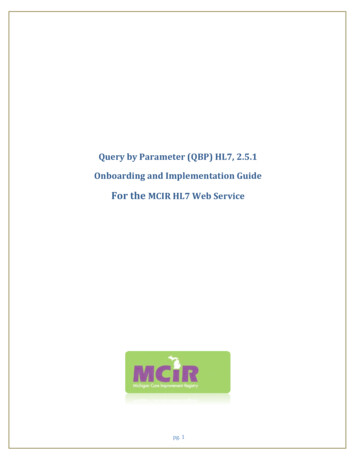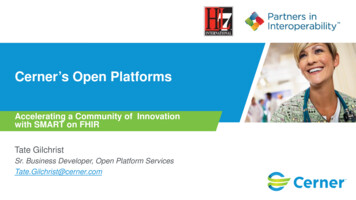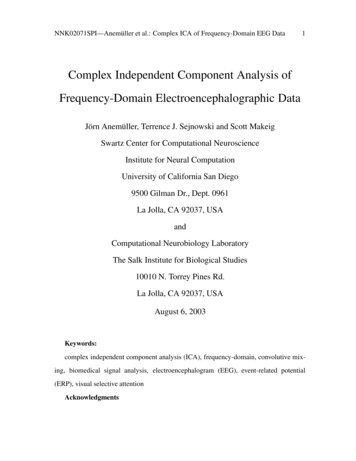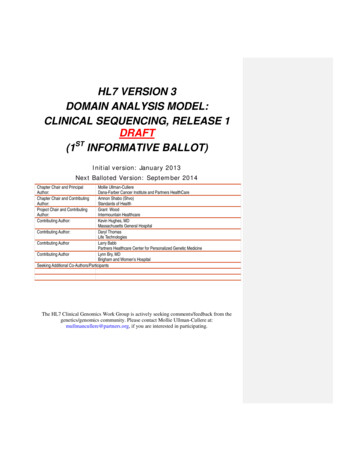
Transcription
HL7 VERSION 3DOMAIN ANALYSIS MODEL:CLINICAL SEQUENCING, RELEASE 1DRAFT(1ST INFORMATIVE BALLOT)Initial version: January 2013Next Balloted Version: September 2014Chapter Chair and PrincipalAuthor:Chapter Chair and ContributingAuthor:Project Chair and ContributingAuthor:Contributing Author:Mollie Ullman-CullereDana-Farber Cancer Institute and Partners HealthCareAmnon Shabo (Shvo)Standards of HealthGrant WoodIntermountain HealthcareKevin Hughes, MDMassachusetts General HospitalContributing Author:Daryl ThomasLife TechnologiesContributing AuthorLarry BabbPartners Healthcare Center for Personalized Genetic MedicineContributing AuthorLynn Bry, MDBrigham and Women’s HospitalSeeking Additional Co-Authors/ParticipantsThe HL7 Clinical Genomics Work Group is actively seeking comments/feedback from thegenetics/genomics community. Please contact Mollie Ullman-Cullere at:mullmancullere@partners.org, if you are interested in participating.
Table of ContentsTABLE OF CONTENTS1. INTRODUCTION . 11.1 Purpose . 11.2 AudIence . 11.3 Scope . 11.4 Assumptions . 22. USE CASE STAKEHOLDERS . 33. ISSUES AND OBSTACLES . 44. PERSPECTIVE . 45. USE CASE SCENARIOS . 55.1 Scenario 1: Specimen Identification . 55.1.1 Germline testing for biomarkers/mutations (usually inherited) . 55.1.2 Tumor testing for somatic (tumor specific biomarkers/mutations) . 55.1.3 Pediatric testing for biomarkers/mutations causal to rare earlychildhood conditions . 65.1.4 Prenatal testing which may be reported on the maternal medicalrecord (and should be identified as separate from germline testing) . 65.1.5 Infectious disease testing, where the biomarker/mutation identifiedwithin the disease causing organism is reported into the patient medicalrecord following similar data standards as used for other testingscenarios above. . 65.2 Scenario 2: Clinical Sequencing – Germline Testing . 75.2.1 Description of Scenario (following numbers in the diagram above) . 85.2.2 Alternative Flow 1: Chart Review. 95.2.3 Alternative Flow 2: New Genetic Knowledge . 95.2.4 Alternative Flow 3: New Clinical Indication . 95.3 Scenario 3: Cancer Profiling – Somatic Testing . 105.3.1 Description of Scenario Differences from Germline Workflow . 105.4 Scenario 4: Decision Making Tools – Family History and Drug DosageCalculators . 115.4.1 Description of Scenario . 115.5 Scenario 5: Public Health Reporting . 125.5.1 Description of Scenario . 125.6 Scenario 6: Clinical and Research Data Warehouses . 135.6.1 Description of Scenario . 136. ADDITIONAL USE CASES RELEASE 1 OR 2? . 146.1 State & Regional HIE . 14Page iiHL7 Version 3 Domain Analysis Model: Clinical Sequencing, Release 1 – DRAFT 2014 Health Level Seven International. All rights reserved.June 2014
Table of Contents6.2 National Marrow Donor Program . 146.3 Cancer Registry workflow . 146.4 Public Health Testing – microbial . 146.5 Newborn Screening . 146.6 commercial testing laboratories . 156.6.1 Defined Genetic Testing vs. Expanding Genetic Tests . 156.7 patient panel management– analytics for care quality . 156.8 Patient genetic profile – data across all testing paltforms . 156.9 FDA Scenarios in Public Health Reporting . 156.10 Additional variant types . 156.10.1 Structural variants . 156.10.1.0 Currently using ISCN standards and stored at NCBI in dbVAR. . 156.10.2 Copy number change . 156.10.2.0 Emerging standards with the following suggestions:. 156.10.3 Biomarkers -- Is this far enough along to add . 156.10.3.0 Add MedGen/LOINC . 156.11 Laboratory genomic data standards . 166.12 Extension of sequence VARIATION AND cytogenetic HL7 models . 167. DATA SET CONSIDERATIONS & STANDARDS FROM THE FIELD . 167.1.1 Genes . 167.1.1.0 HGNC gene symbols (required) . 167.1.2 Sequence Variations . 167.1.2.0 HGVS (required) . 167.1.2.1 dbSNP (optional, but highly recommended) . 177.1.2.2 COSMIC (optional) . 177.1.3 Reference Sequences (required) . 187.1.3.0 RefSeq . 187.1.3.1 LRG . 187.1.4 Publicly Available References (valuable for clinical andtranslational genomics) . 197.1.4.0 OMIM (optional) . 197.1.4.1 PubMed (optional) . 197.1.4.2 PharmGKB (optional) . 197.1.4.3 ClinicalTrials.gov (optional) . 208. VOCABULARY CONSTRAINTS . 219. REVIEW OF EXISITING HL7 CLINICAL GENOMICS SPECIFICATIONS . 22HL7 Version 3 Domain Analysis Model: Clinical Sequencing, Release 1 - DRAFTPage iiiJanuary 2013 2013 Health Level Seven International. All rights reserved.
Table of Contents9.1 HL7 V2 Genetic Test result message . 229.2 HL7 CDA Implementaion Guide for Genetic testing reports . 2210. HIT DATA STANDARDS . 2310.1 fAMILY HISTORY. 2310.2 Sequence Variations / Chromosomal change . 2310.2.1 Small Genetic Variations within a Gene . 2310.2.2 Structural Variations . 2311. HL7 ENCAPSULATION OF GENOMIC DATA FILES . 2312. CLINICAL GRADE-GENOMIC DATA FILE STANDARDS . 2313. GAPS & EXTENSIONS . 2413.1 Laboratory order entry . 2414. OUTSTANDING QUESTIONS . 2415. GLOSSARY . 2415.1 Extension to Specimen scenarios. 2415.1.1 Microbiome analysis of the patient . 24Page ivHL7 Version 3 Domain Analysis Model: Clinical Sequencing, Release 1 – DRAFT 2014 Health Level Seven International. All rights reserved.June 2014
Chapter 1: Introduction1. IntroductionIn March, 2008, the United States Department of Health and Human Services, Office of the NationalCoordinator for Health IT published the Personalized Healthcare Detailed Use Case add reference topublication 6/ in response to a request andspecifications from the American Health Information Community. The use case focuses on supportingsecure access to electronic genetic laboratory results and interpretations for clinical care, as well asfamily history and associated risk assessments by authorized parties and is driven by the need for timelyelectronic access to ordered, referred and historical genetic laboratory results and family history. Orderingclinicians receive genetic laboratory test results as a response to an order by having the genetic testresults sent either directly to the clinician’s EHR system (local or remote) or to another clinical datasystem in support of the provisioning of historical results.Members of the HL7 Clinical Genomics work group participated in the ONC use case development and inparallel extended HL7 messaging standards and wrote implementation guides to support the describedscenarios.Family History-Pedigree – Family HistoryIG for Family HistoryClinical Genetic Testing-IG for Genetic Variants 2.5.1CDA – GTR v3IG for CytogeneticsMuch has changed since 2008 and much remains the same. The HL7 Version 3 Domain Analysis Model:Clinical Sequencing, Release 1 catalogs the breadth of genetic/genomic testing use cases and clinicalscenarios, discusses current challenges and lessons learned, and raises questions to consider for futureimplementations. While this document discusses the use of new technology (Next GenerationSequencing (NGS)), it must be remembered that the vast majority of clinical genetic testing is stillperformed on testing platforms in use ten years ago, and it is the goal of the Clinical Genomics workgroup to facilitate platform- independent, interoperability of genetic/genomic data.1.1 PURPOSEThe HL7 Version 3 Domain Analysis Model: Clinical Sequencing, Release 1 should be used to informstandards developers and implementers, for the design scalable, interoperable solutions covering thebreadth of clinical scenarios.1.2 AUDIENCEThis guide is designed to be used by analysts and developers who require guidance on incorporation ofgenomic data in the clinical and clinical research healthcare IT environment. In addition, developers ofgenomic and healthcare IT data standards may use this guide to extend these standards for support ofclinical sequencing. Users of this guide must be familiar with the details of HL7 message constructionand processing. This guide is not intended to be a tutorial on that subject.1.3 SCOPEThis domain analysis model details a variety of use case scenarios key to personalized genomic medicineand translational research, including more typical scenario for testing of a person’s inherited or germlinegenome, cancer genomics/tumor profiling, early childhood developmental delay, neonatal testing, andHL7 Version 3 Domain Analysis Model: Clinical Sequencing, Release 1 - DRAFTPage 1June 2014 2014 Health Level Seven International. All rights reserved.
Chapter 1: Introductionnewborn screening. In addition, the use case includes two scenarios where test results are manuallytranslated from reports into either a tool for clinical decision making (e.g. family history or drug dosagecalculator) or for public health reporting for cancer registries.1.4 ASSUMPTIONSAssumptions are summarized as follows: Infrastructure is in place to allow accurate information exchange between information systems. Providers access laboratory test results through either an EHR or a clinical information system. Privacy and security has been implemented at an acceptable level. All participants agree to all standards, methodologies, consent, privacy and security. Legal and governance issues regarding data access authorizations, data ownership and data useare outside the scope of this document. The order, paper or electronic, associated with the laboratory result contains sufficient informationfor the laboratory to construct the laboratory result message properly.Page 2HL7 Version 3 Domain Analysis Model: Clinical Sequencing, Release 1 – DRAFT 2014 Health Level Seven International. All rights reserved.June 2014
Chapter 5: Use Case Scenarios2. Use Case StakeholdersStakeholderContextual DescriptionAnatomic & SurgicalPathologyFor cancer profiling (i.e. genetic testing of cancer specimens),the pathologic diagnosis will play a key role in testing andinterpretation of the findings.Geneticist /Medical Geneticist /Molecular PathologistProfessionals interpreting the clinical implications of a patient’sgenetic data.These professionals may work within thelaboratory setting or outside the laboratory.Healthcare EntitiesOrganizations delivering healthcare.Healthcare PayorsHealthcare Insurers and Centers for Medicare & MedicaidServicesInformation TechnologyVendorsVendors supplying information technology solutionssupport.andLaboratories - ReferenceTesting laboratories outside the hospital environment either asa separate corporate entity or separate unit of the sameorganization.Laboratories - HospitalTesting laboratory which is part of the hospital entity andhospital laboratories.Manufacturers/DistributorsEntities involved in the development, production, anddistribution of products used in healthcare (e.g. in vitrodiagnostic tests)PatientsMembers of the public that use healthcare services.Public Health AgenciesAgencies which help to protect and improve health andhealthcare of the public.RegistriesSystems for the collection, analysis, and distribution of data forthe improvement of public health.HL7 Version 3 Domain Analysis Model: Clinical Sequencing, Release 1 - DRAFTPage 3June 2014 2014 Health Level Seven International. All rights reserved.
Chapter 5: Use Case Scenarios3.Issues and ObstaclesNumerous challenges exist in the area of policy, patient and clinician education, and reimbursement,which are beyond the scope of this document, unless requiring consideration within the informationtechnology solutions (e.g. clinical decision support). Key challenges for information technology include:data security, adoption of electronic health records and laboratory information management systems, andinteroperability, and structuring of useful data. This document informs information technology vendors ofkey functionality for clinical sequencing, and outlines considerations for healthcare providers andlaboratories investing in information technology.4.PerspectiveThis document includes perspectives of stakeholder groups outlined in section 2. Integration of moleculardiagnostics into the clinical workflow is key for safe, efficient and effective adoption. For instance, thepotential for medical error during drug order entry is reduced with clinical decision support which alertsthe clinician, if ordering a drug which is contraindicated. Developing systems which are capable ofconsideration of genetic markers associated with drug metabolism, efficacy, and toxicity during the orderentry process will reduce medial error, as our knowledge increases.Page 4HL7 Version 3 Domain Analysis Model: Clinical Sequencing, Release 1 – DRAFT 2014 Health Level Seven International. All rights reserved.June 2014
Chapter 5: Use Case Scenarios5.Use Case Scenarios5.1 SCENARIO 1: SPECIMEN IDENTIFICATIONUse Cases for sequencing require explicate identification of 1 or more specimens to be used in laboratoryanalysis. This likely requires the identification of specimen groups (i.e. separate specimens andassociated derivatives) originating from the same patient/subject or related patients/subjects.5.1.1 Germline testing for biomarkers/mutations (usually inherited)In terms of specimen identification, this is the most straightforward scenario. Typically a blood sample orcheek swab will be taken from the patient and DNA extracted. Except for l
results sent either directly to the clinician’s EHR system (local or remote) or to another clinical data system in support of the provisioning of historical results. Members of the HL7 Clinical Genomics work
